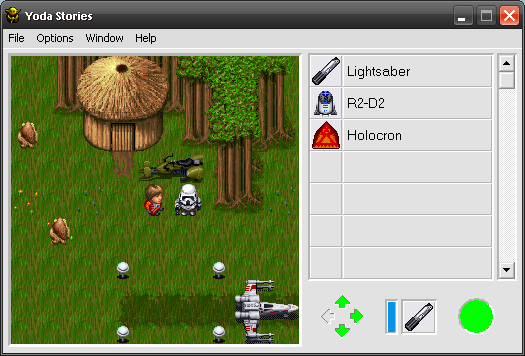Yoda Stories wasn’t much more than a lightweight diversion for preteens with a propensity to hog time on the family desktop. With an overhead view, players guided a cartoonishly large-headed Luke Skywalker, ordered by Yoda to visit various planets to save his friends, collect piles of robot junk, and swing a lightsaber around.
The game was an installment in LucasArts’ stalled “Desktop Adventure” series—low-key, cutesy titles that require about as much investment as your average game of Minesweeper or Solitaire. It spit out randomly created maps of various Star Wars-esque locales. (Desert planet? Frozen planet? Forest planet? Check, check, check). It’s in the same vein of early-90s lightweight PC action titles like Chip’s Challenge, but it has the bonus of giving the player the excuse to run around and bash on Stormtroopers.
Playing it now, in my thirties, I’m questioning whether it was worth the hours I sunk into it on our screaming-fast 133mhz computer. It’s a clunky, poorly written cash-in on the series, with bloopy, cartoonish sound effects. The seemingly never-ending permutations of adventures apparently were just variations on 15 levels. Its clearest descendent is the type of game you get Facebook invites to play with from former high school classmates.
But as a kid, this little timewaster stirred my fascination with just how expansive that galaxy could be.

When Yoda Stories hit the shelves of local Babbage’s in March 1997, moviegoers had two months prior been treated to A New Hope: Special Edition, the first installment in a decades-long feud with George Lucas as he futzed with minute (and major) alterations to the original films. An updated wave of action figures were hogging allowances. The Expanded Universe, previously conversation fodder for sci-fi conventioneers and comic-shop junkies, had gone semi-mainstream with Shadows of the Empire, a novelization about the space between Empire and Jedi that received the same kind of promotion reserved for a new film. We were well in the midst of a Star Wars media blitz.
Of the three original films, it’s that gap between The Empire Strikes Back and Return of the Jedi that provides the most room for the imagination to run wild. Lando and Chewie blast off to find a frozen Han Solo and wind up embedded spies in Jabba’s palace. Luke transforms from a broken and battered Jedi-in-training to a cloaked, sinister-looking master. Leia ended Empire standing beside Luke as a supportive friend, and the next time we see her, she’s the closest the series ever comes to an empowered female character, impersonating a notoriously fearsome bounty hunter.
How did these characters get from A to B? We had an overabundance of action figures, free time and imagination to act out these adventures, and a videogame playground aimed at kids made perfect sense to keep stoking those daydreams.

And so Yoda Stories dumps the player in the midst of the “what if” that’s essential to loving these films, sending the player out on a few less-than-vital missions. Waving a lightsaber at giant desert bugs to save C3PO’s head from jawas isn’t exactly captivating in 2015, but there was a charming clunkiness to the affair that kept me stuck on it far longer than I expected.
Before “procedurally generated” was back-of-the-box selling point for videogames, Yoda Stories plunked unsuspecting kids into an X-wing and told them to go run around in literally hundreds of randomly generated maps. Played today, it’s redolent of that era before there were prequels and midichlorians. It tapped into the imagination of kids wanting to bash together action figures and take Luke on more adventures around the galaxy, and for that alone I’m glad it existed. Also, for how funny bighead Luke Skywalker looks.
